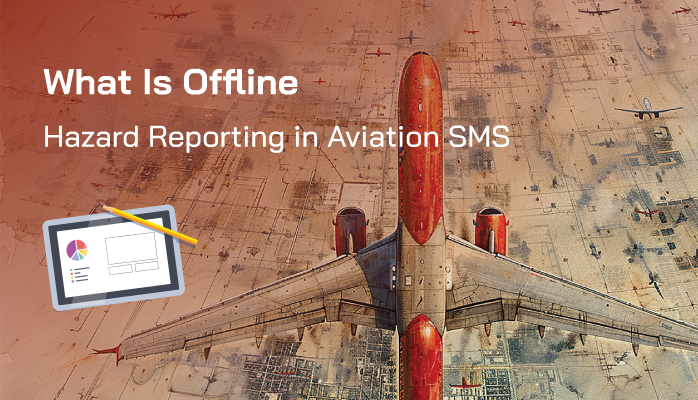Everyone Understands Hazard Reporting

Every aviation safety professional has heard of a "hazard reporting system" in regards to aviation safety management systems (SMS). You may call your hazard reporting system by another name, such as the safety reporting system, but the purpose of the system remains the same: allow stakeholders to communicate safety information to safety teams which will use the information to manage risk.
The intent of hazard reporting goes beyond merely hazard identification in a fully implemented aviation SMS.
Safety managers are constantly urging employees to report any:
- Accident;
- Incident (including close calls); or
- Irregularity (which is commonly a hazard).
Related Aviation Safety Reporting Articles
- What Is Missing Most in Aviation Safety Reporting Systems?
- 4 Hard Truths About Hazard and Safety Reporting in Aviation SMS
- How to Develop Healthy Safety Reporting Cultures in Aviation SMS
What Are Objectives of Aviation Safety Reporting Systems
The over-arching objectives of an aviation SMS' safety reporting system are to:
- identify potential hazards;
- communicate potential safety concerns to appropriate management personnel;
- determine risk;
- implement measures that mitigate the risk; and
- continue to monitor the system to verify successful mitigation.
User-friendly, easily accessible safety reporting systems are required in order for an aviation SMS to function as designed and to reach its full potential. Otherwise, the operator may as well have a paper SMS, which is perfectly acceptable as long as this "paper SMS" aligns with key business processes.
Not every operator requires or desires a full-blown SMS implementation. The accountable executive may realistically assess that their safety culture is not conducive to open, trust-worthy communications between line employees and management. This is better examined in another article. The short explanation is that not every organization will benefit financially from an SMS implementation because of ingrained safety culture challenges.
Best Practices for Hazard Reporting Database
Hazard reporting forms have evolved from verbal and paper-based methodologies to the almost ubiquitous online reporting form. From what I've seen, only approximately 50% of online hazard reporting forms are directly tied to the aviation risk management database. This is a huge inefficiency for the reporting systems that are not directly integrated with the operator's risk management system.
Best practices dictate that data pulled from hazard reporting forms in the safety reporting system should be instantly and automatically transferred to the central SMS data repository for immediate treatment using the aviation SMS's documented risk management processes.
I'm assuming you know what a hazard reporting form is. A hazard reporting form is a collection of data points your company wishes to collect whenever possible as employees and other stakeholders submit hazard reports.
Until recently, I also assumed everyone intuitively understood what is an "offline hazard reporting form" and how it relates to their aviation SMS database.
I was wrong. Let's clarify this so you completely understand offline hazard reporting should the topic arise. You may also wish to employ offline hazard reporting in your SMS tool kit. There are several benefits beyond the obvious points.
Related Aviation Safety Reporting Articles
- How Safety Managers Hurt Safety Reporting Performance - Aviation SMS
- How to Get Employees Participating in Safety Reporting - Aviation SMS
- How to Monitor Aviation Safety Reporting Culture Using Safety Charts
Offline Reporting Used on Many Device Types
When you think of using a Web-enabled tool offline, you may think of the times you are flying to the North Pole or a remote African destination and spending a few days without the Internet. Or you may be operating in remote parts of the world where the Internet is very slow or nonexistent, such as many parts of Southeast Asia.
In these cases, you may not have reliable access to the Internet. As you would intuitively suspect, Offline Reporting Tools are suited for these use cases.
However, you must have the "app" on your device, whether it is an:
- iPhone;
- iPad;
- MS Surface;
- Tablet; or
- Laptop.
In short, you need to get the offline reporting app onto your device, and this is done when you are connected to the Internet. Therefore, before you leave the base, make sure you put the offline reporting app onto the device you are carrying, which could be your electronic flight bag.
Offline Reporting Used Online Also

We understand that offline reporting tools were developed to allow employees to report safety issues where either:
- No Internet was available; or
- Internet is often sporadic; or
- Internet connectivity is abysmally slow.
This last point is critical for you to understand. Just because you are connected to the Internet does not mean you should not use offline reporting tools. I recommend using the offline reporting forms whenever you report a safety issue because:
- Forms load up instantly because they are already on your device;
- You don't need to login to the online SMS database; and
- I don't have to worry about the session timing out and losing my narrative.
The speed of an offline reporting form is the number one reason I would use them and encourage you to use them. I don't care if you have the fastest Internet in New York City, the offline reporting form will always load more quickly because it is already installed onto your device.
The second point about the session timing out and the user losing data may not be necessary any longer. SMS Pro has a way to recover user data should there be a problem when the user submits an issue. See this demo video on hazard reporting for more details and a very good example. If you don't have this technology at your company, it is not difficult to implement. Your IT staff should be able to make it happen within a week or two. If not, contact us for a demo.
Related Aviation Safety Reporting Articles
- How to Analyze Safety Reporting Performance in Aviation SMS Using Charts
- How Spreadsheets Not EASA Compliant Aviation Safety Reporting Database
- How Confidential Aviation Safety Reporting Systems Offer Assurance to Employees
Offline Reporting Does Not Always Mean App From Store
I am frequently asked whether SMS Pro has an "app." These people are typically expecting an app from either:
- Apple store;
- Google Play store;
- Amazon App store; or
- Other online app stores.
Several years ago, the IT industry recognized the inefficiencies of these "app stores" and came up with another solution that would work on all devices. As you could expect, if you put an offline reporting tool onto the Apple store, this is great for iPhone and iPad users, but for those of us using Android or Windows-based systems, these "Apple apps" offered little value.
Consequently, companies would have to either:
- Put their apps onto both the Apple & Google stores; or
- Come up with another solution to offer an "app-like" experience.
That other solution was HTML5. HTML5 supports offline methodologies. To the end user, the hazard reporting application may look just like an app.
HTML5 offline capabilities only work on modern browsers. This is the key point: you are using your device's internal browser, which could be
- Skyfire;
- Opera Mini;
- Chrome;
- Safari; or
- Firefox Mobile.
You Have to Be Connected to Report

I have to state the obvious for the 5% who are technically challenged.
While you can draft your safety report while you are offline, you must be online to submit the report.
A great feature of any offline safety reporting tool is to allow users to create multiple safety reports and then submit them once Internet connectivity is re-established. I always recommend reviewing your accident or hazard report details before submitting them. There were many times when I wasn't ready to send an email and it fired because I did something odd, like letting my five-year-old daughter near the keyboard. A quick review may save needless inquiries from the safety department.
Offline Reporting Forms More Expensive to Develop
Aviation service providers like the idea of having an offline reporting form to reduce the friction employees feel when reporting safety issues. Before you take the plunge and commit IT resources to build your offline reporting forms, you should be aware that offline safety reporting forms take three to four times longer to develop than their online counterparts.
Why? It's due to technology.
- JavaScript is more difficult to debug.
- Offline reporting forms are harder to test.
- Offline errors may be difficult to trace.
A good rule of thumb is first to determine how much an online reporting form will cost you. Then multiply this by four or five.
With online reporting, we can easily create server logs to track errors. However, with the offline reporting forms, the error may be stored on the device and we don't have access to the device.
Have You Read
- How to Make Effective Hazard Reporting Forms for Aviation SMS
- Understanding Hazard Report Forms in Aviation SMS
- Examples of Good Hazard Reporting Forms in Aviation Safety
Finally, Offline Reporting Is Cool
As you can guess, I'm a big fan of using offline reporting tools. Even in Anchorage, Alaska, our Internet sometimes cuts out at the office. It may be due to a network conflict or a backhoe digging up the fiber optic and bringing down the block.
When I'm offline, I can quickly fill out the report at my leisure and send it when I'm ready. There is no hurry and I don't have to worry about an online session timing out.
Next time somebody asks you about offline reporting, I'm hoping you are better informed and know what to expect. Offline reporting is a great way to reduce friction with employees toward your SMS program. If you want to encourage employee hazard reporting, consider offline hazard reporting tools.
SMS Pro has both Offline Hazard Reporting and Offline Auditing. To learn how SMS Pro can help your SMS mature, check out these short demo videos. Since 2007, SMS Pro has been providing aviation SMS databases to operators around the world.
Live SMS Pro Demo
Prefer to see SMS Pro live? Sign up for a free online demo.
If you need offline auditing tools, check out the Safety-Quality Assurance Solution.
Last updated December 2024.









